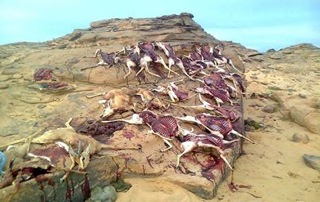By Seraj Essul and Reem Tombokti.

Tripoli, 10 August 2013:
Two years of unregulated hunting in the south of the country has left . . .[restrict]three types of Libyan gazelle on the verge of extinction.
“We had a wealth of these gazelles, but sadly their numbers have gone down and they are now facing extinction,” the chairman of the Al-Haya Association for the Protection of Wildlife, Ibraheem Al-Gahwajy, told the Libya Herald.
The problem is most acute in the south of the country, near the borders of Chad and Algeria, the main habitat for ‘Rhim’ and ‘Dorcas’ gazelles. The ‘Oueddan’ gazelle, which inhabits the Haruj mountains of central Libya, is also said to be facing exteniction.
For many years, under the old regime, the hunting of gazelles was banned. However, since the revolution, the practice has taken off as a sport and is, at present, completely unregulated.
“It is a desire to murder, rather than a hunting hobby,” Al-Haya’s president Saleh Nuwaiji said. The proliferation of weapons and the increasing ownership of four-wheel drive vehicles were, he said, partly responsible for the rise in popularity of gazelle-hunting. He also pointed the finger of blame at a lack of legislation regulating the sport, as well as local ignorance about breeding seasons, which led to indiscriminate killings even of young animals.
The full severity of the problem has only recently come to light, after videos appeared on YouTube showing people hunting at sites across the Libyan desert.
With numbers dwindling to worrying levels at the hands of bloodthirsty hunters, Libyan environmental activists are now calling for an end to what they say is an “eradication campaigns against gazelles.” The activists are asking the Ministry of Agriculture and Environment, as well as civil society organisations, to take responsibility for the country’s wildlife and fight gazelle poaching.
Al-Haya has also emphasised the important role that nature reserves could have in protecting the gazelles. “Nature Reserves need to be reassessed because so far they haven’t provided any protection to this species,” said Ghawajy.
There is one area that would, apparently, be particularly suitable. It features rugged terrain, which has access points only through three valleys which, according to Nuwaiji, would be relatively simple to turn into a nature reserve that could help save the gazelles from extinction. He added that the reserve could initially be populated by privately-owned gazelles of which, he said, there are around 70 in the country.
“Our hopes are big and we know this will take time,” Ghawajy said. Until the government takes action, the Al-Haya Association continues to raise awareness of the problem by giving public lectures across the country. [/restrict]








